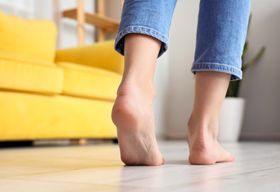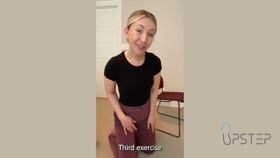Heel Spurs: An Overview of Symptoms, Causes, and Treatments
Updated December 7, 2022

A heel spur is a bony protrusion on the heel, which is usually felt in the middle of the underside of the heel. It is a common condition and is often the cause of heel pain, as the spur eventually leads to inflammation and pain as the tissue becomes aggravated. While heel spurs aren’t usually dangerous, in some cases they can limit your physical and daily activities, and therefore, require treatment.
Causes of Heel Spurs
Internal Causes
Possible internal causes of heel spurs include:
- Repetitive stress: Continuous stress on the heel causes calcium deposition. Over time, the calcium deposits become bony spurs or osteophytes and compress the soft tissue of the foot whenever there is pressure on the heel.
- Weight: Obesity increases the chances of developing heel spurs.
- Gender: Females are more likely to develop heel spurs than males.
External Causes
Heel spurs may also be externally induced.
- Hard surfaces: Walking, running, and jumping on hard surfaces can strain the foot muscles and ligaments leading to heel spur formation.
- Poorly fitting shoes: When shoes don’t provide proper support, they can cause heel spurs.
- Standing on your feet: Especially for long periods at a time.
- Gait abnormalities: This includes increased heel strikes when running or walking.
- Plantar fasciitis: There is some connection between heel spurs and plantar fasciitis, especially when the latter is left untreated or improperly managed. The injury to the plantar fascia easily becomes a site for calcium deposition and consequently, heel spur growth.
Symptoms of a Heel Spur
The symptoms associated with heel spurs include:
- Sharp, stabbing sensations in the heel, usually in the morning when standing up
- A constant, dull ache in the heel hat persists over the course of the day
- Pain in the central heel when touched or weight is placed on the foot
- Inflammation and swelling of the heel
- A sensation of heat around the foot
- Point tenderness at the bottom of the heel
How to Treat a Heel Spur
Non-Surgical Treatment
There is a host of conservative treatments for heel spurs, including:
- Ice: Applying ice to the heel can relieve inflammation
- Orthotics: They cushion the heel and reduce the shock applied to the foot while running or walking. This reduces inflammation, and consequently, pain.
- Anti-inflammatory medication: This can provide you with immediate pain relief, so you can complete daily tasks as normal. These medications, however, are associated with side effects such as stomach ulcers and kidney issues.
- Stretching: The muscles and structures of the calf muscle complex may provide you with relief from pain and inflammation by reducing the strain placed on the soft tissue around the spur itself. Stretching the muscles of the foot may also help.
- Corticosteroid injections: These are administered by medical professionals and provide symptom relief for about 3 to 6 months. One cannot get multiple steroid injections as it increases the likelihood of complications such as a tendon rupture. They also aren't a cure for this condition.
» Want to treat your heel spurs at home? Discover the best home remedies for heel spurs
Surgical Treatment
Should the spur protrude to the extent that the soft tissue is inflamed, and other pain remedies have failed to reduce your symptoms, surgical interventions might be considered. During this procedure, the spur is removed, but the recovery process may be quite extensive. At least 3 weeks are spent on crutches after the surgery, and it may take further time to be fully symptom-free.
» Does chiropractic therapy help with heel spur pain? Find out how a chiropractic adjustment works
Can Heel Spurs Be Prevented?
Heel spurs are oftentimes preventable. Treating the conditions that could potentially contribute to the development of heel spurs is paramount in preventing the growth of a heel spur.
Preventative measures aiming to reduce the strain and stress applied to the muscles, ligaments, tendons, and bones of the foot will help lower the risk of developing a heel spur. Using orthotics or specialized shoes is one prevention method, as it limits the shock placed through the heel.
Vitamins and minerals, such as magnesium and vitamin D are essential for calcium absorption, and therefore, slow the development of heel spurs. These vitamins can be consumed in a healthy, balanced diet and usually do not require supplementation.
Should your symptoms or pain become debilitating and limits your mobility, seek advice from a medical professional regarding treatment options for your heel spurs.
» Think orthotics are the answer? Choose the right heel spur insert for you








